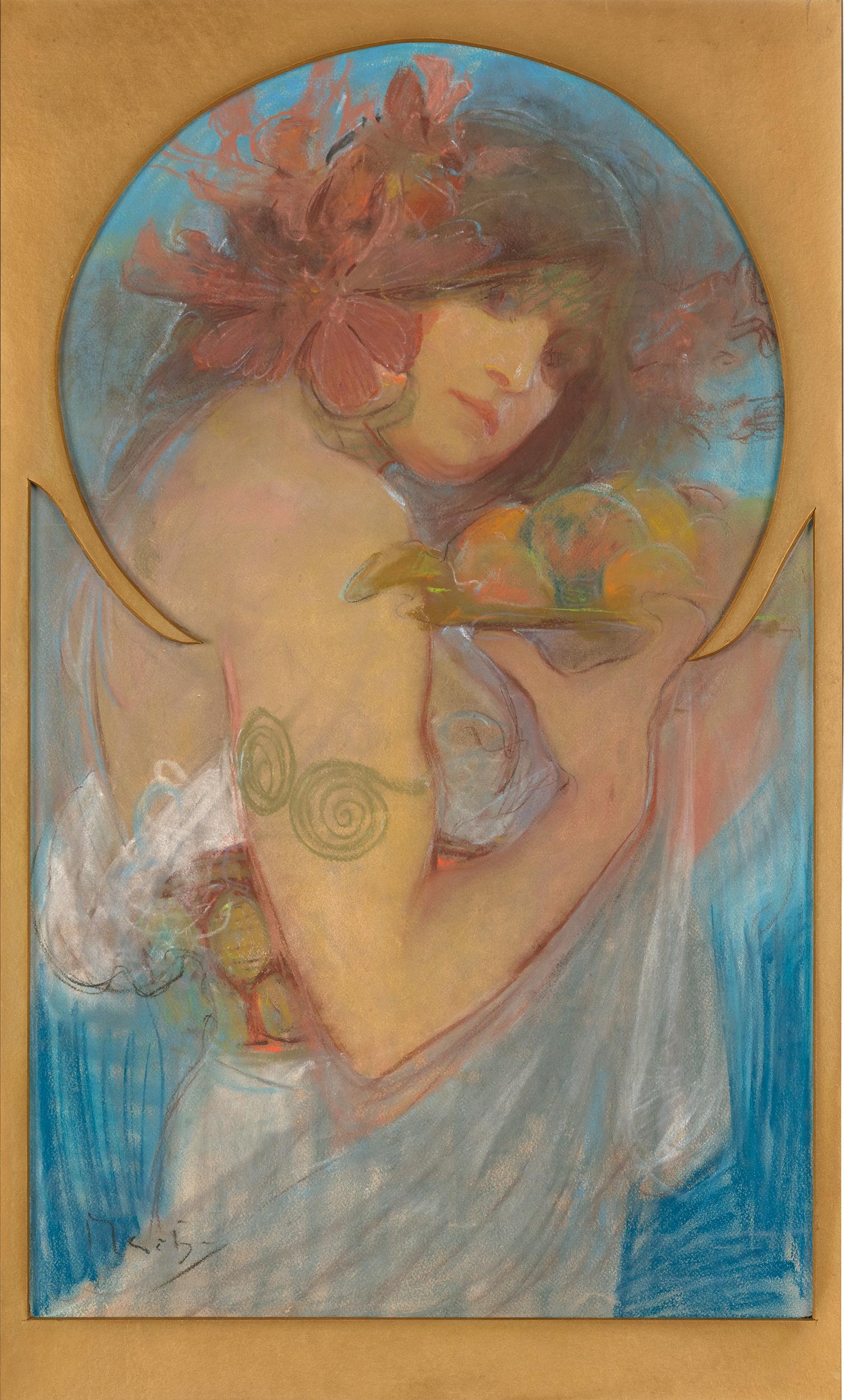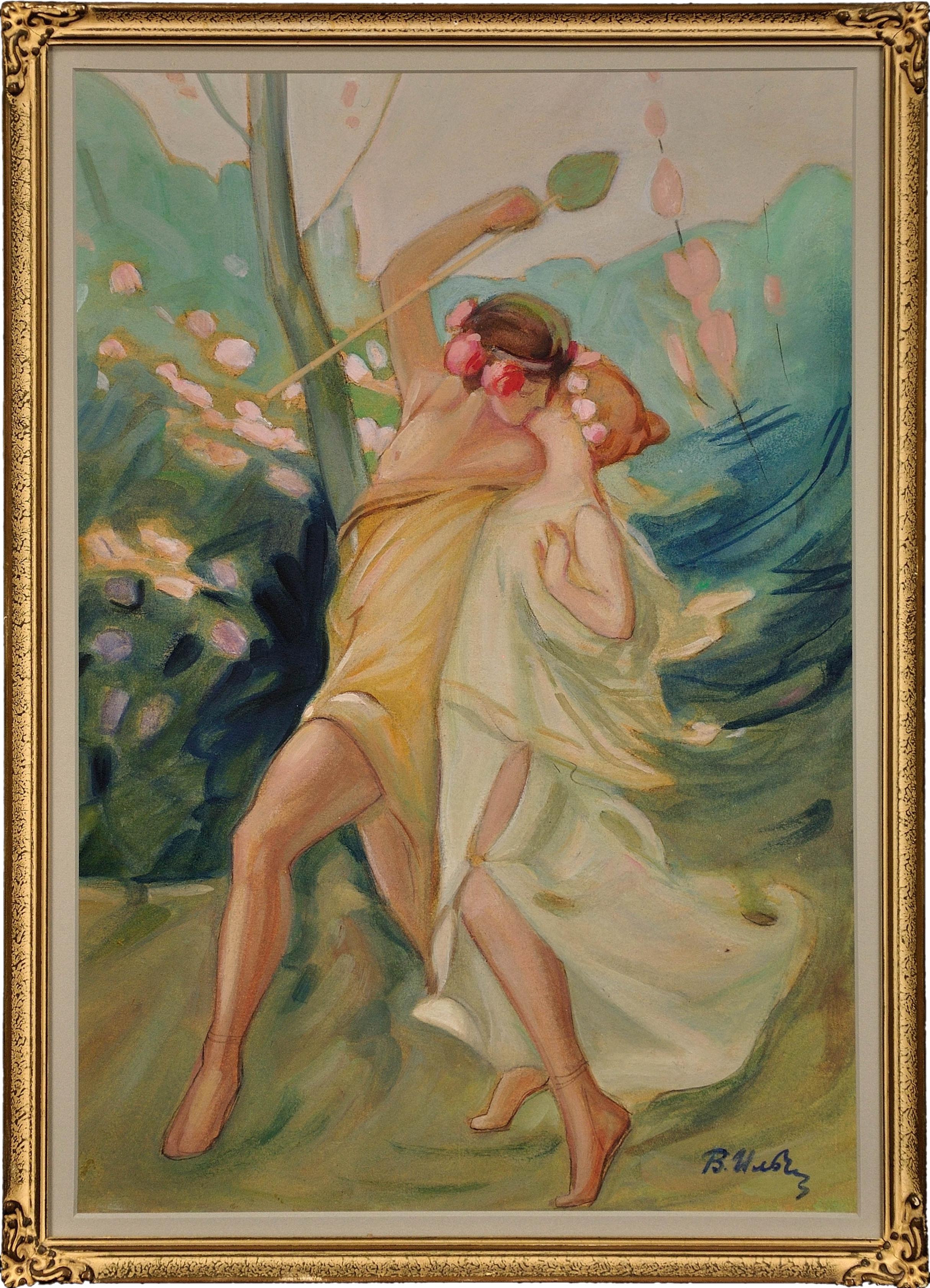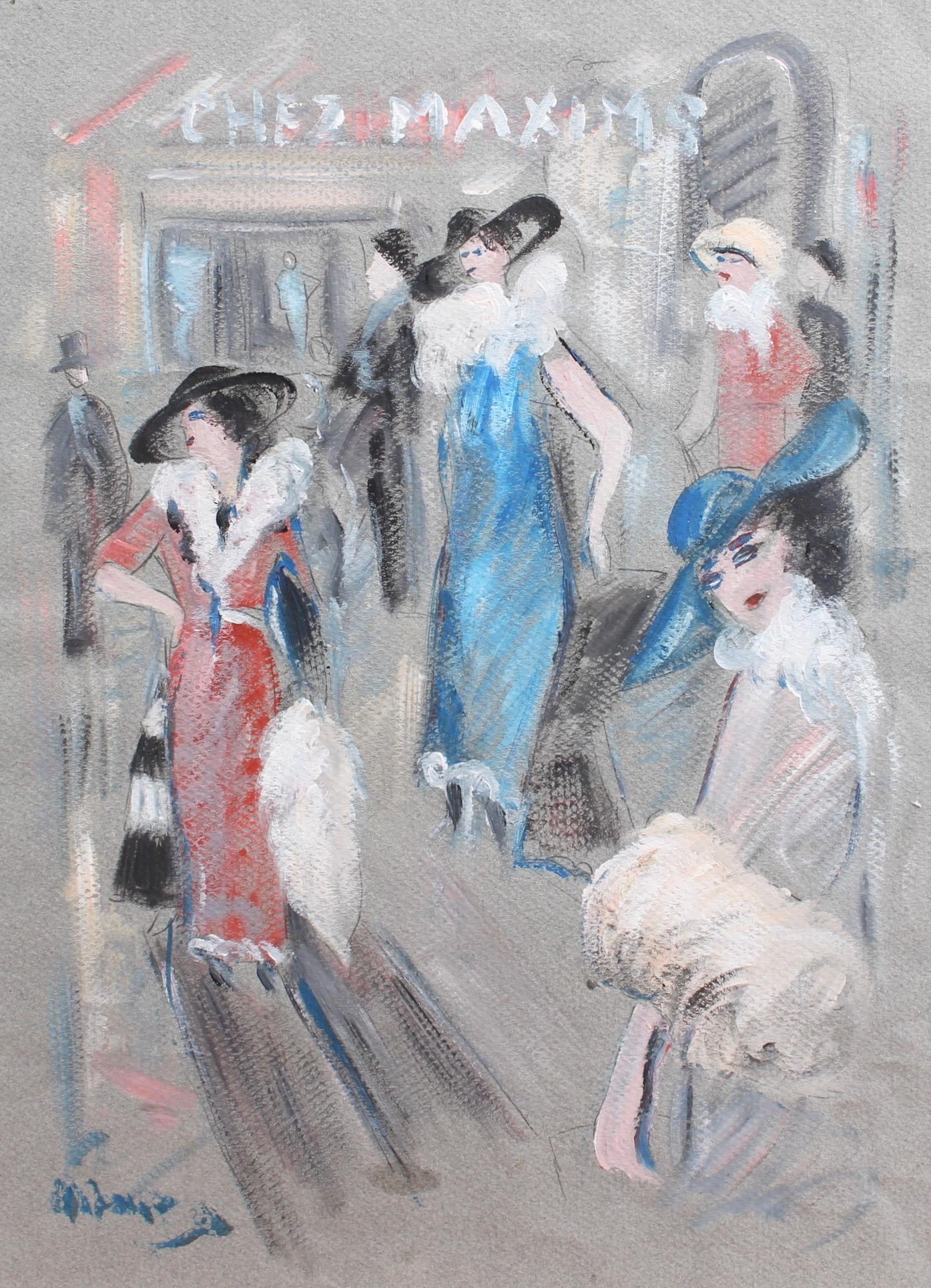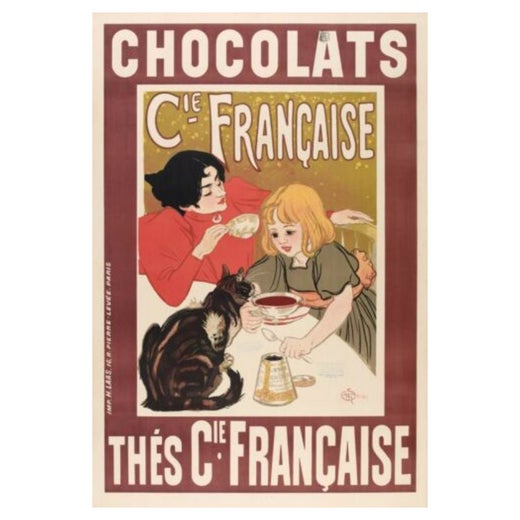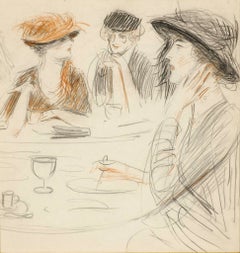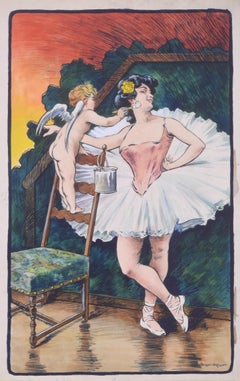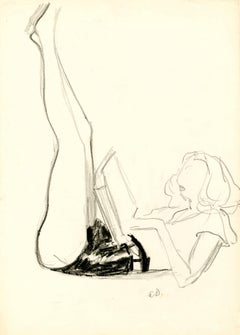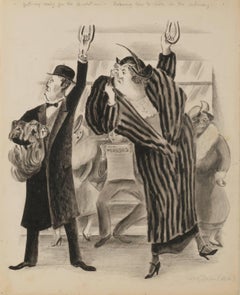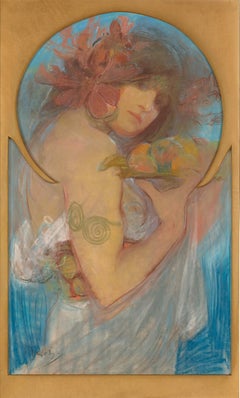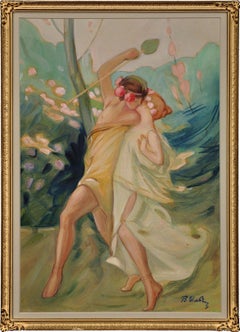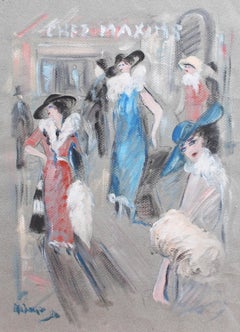Items Similar to Double sided crayon drawing in colors: Study for "The Shoe" (recto)
Want more images or videos?
Request additional images or videos from the seller
1 of 14
Théophile Alexandre SteinlenDouble sided crayon drawing in colors: Study for "The Shoe" (recto)1899
1899
About the Item
Double sided crayon drawing:
Front: Study for "The Shoe"
Reverse: Studies of Figures
Blue crayon, red and black crayons
Image size: 19.25 x 15.375 inches
Frame size: 30 x 25 1/2 inches
Signed with the estate stamp, Lugt 2312b, recto and verso
Annotated on verso in blue pencil: “On Demande des petites femmes”
Illustrated: Alan M. Fern, Theophile-Alexandre Steinlen, Charles E. Slatkin Galleries, 1963, nos. 55 and 53
Note: This drawing is a preliminary drawing for the cover illustration for Lucien Puech, On Demande des Petites Femmes, published in Gil Blas, June, 23, 1899. Gil Blas (or Le Gil Blas) was a Parisian literary periodical named for Alain-René Lesage's novel Gil Blas. It was founded by the sculptor Augustin-Alexandre Dumont in November 1879.
Provenance: Charles E. Slatkin Galleries, New York (label)
- Creator:Théophile Alexandre Steinlen (1859 - 1923, French)
- Creation Year:1899
- Dimensions:Height: 19.25 in (48.9 cm)Width: 15.375 in (39.06 cm)
- Medium:
- Movement & Style:
- Period:
- Condition:Usual aging to a 120 year old drawing.
- Gallery Location:Fairlawn, OH
- Reference Number:Seller: FA98521stDibs: LU14014530762
Théophile Alexandre Steinlen
Theophile Alexandre Steinlen was born in Lausanne in 1859. He was naturalized French in 1901. He was a painter, engraver, illustrator, poster artist and sculptor. Before settling in Paris, he made a detour to Mulhouse where one of his uncles placed him in the studio of one of the best lithographers of the time. He settled definitively in Montmartre in 1881. Willette introduced him to his companions of the Cabaret du Chat-Noir animated by Rodolphe Salis. He met Toulouse-Lautrec, Forain, Léandre, Debussy, Eric Satie, Verlaine, Alphonse Allais and Aristide Bruant. He took part in the performances of the famous cabaret's shadow theater with animal stories and, most often, sequences featuring cats, for which he has a particular affection. The felines will appear throughout his activity as "parentheses" in a tormented work. There is, in this torment, the expression of no personal problem but a painful compassion for the lives of the exploited and marginal beings. He painted and drew idylls, balls and bastrings, workers, kids and gosselin, the poor, the little workers, girls and marlous. He sometimes made posters. In the most successful of them (« Le lait pur de la Vingeanne » et le « Fer Bravais ») he imposed, relevant or not, the presence of cats.
In 1901, Steinlen worked for L'Assiette au beurre , the most virulent satirical newspaper ever published and takes readily to target the institutions of the 3rd Republic.
His works are found in numerous Public Collections, such as Petit Palais in Geneva, Hermitage Museum in Saint Petersburg, and the National Gallery of Art in Washington.
About the Seller
5.0
Recognized Seller
These prestigious sellers are industry leaders and represent the highest echelon for item quality and design.
Platinum Seller
Premium sellers with a 4.7+ rating and 24-hour response times
Established in 1978
1stDibs seller since 2013
787 sales on 1stDibs
Typical response time: <1 hour
Associations
International Fine Print Dealers Association
- ShippingRetrieving quote...Shipping from: Fairlawn, OH
- Return Policy
Authenticity Guarantee
In the unlikely event there’s an issue with an item’s authenticity, contact us within 1 year for a full refund. DetailsMoney-Back Guarantee
If your item is not as described, is damaged in transit, or does not arrive, contact us within 7 days for a full refund. Details24-Hour Cancellation
You have a 24-hour grace period in which to reconsider your purchase, with no questions asked.Vetted Professional Sellers
Our world-class sellers must adhere to strict standards for service and quality, maintaining the integrity of our listings.Price-Match Guarantee
If you find that a seller listed the same item for a lower price elsewhere, we’ll match it.Trusted Global Delivery
Our best-in-class carrier network provides specialized shipping options worldwide, including custom delivery.More From This Seller
View AllTea at the Ritz, New York
By Paul César Helleu
Located in Fairlawn, OH
Tea at the Ritz, New York
Colored chalk, 1912
Signed with the estate stamp verso. (see photo)
Authenticated by the artist's daughter, Mme Paulette Johnston.
Image size: 10 5/8 x 10 1...
Category
1920s Art Nouveau Drawings and Watercolor Paintings
Materials
Chalk
Ballarina having make up applied by Cupid
Located in Fairlawn, OH
Ballarina having make up applied by Cupid
Watercolor and gouache on heavy wove paper, c. 1905
Signed in ink lower right
Titled in pencil, verso
Condition: Aging to sheet
Colors...
Category
Early 1900s Art Nouveau Figurative Drawings and Watercolors
Materials
Watercolor
Eileen Lake
By Adolf Arthur Dehn
Located in Fairlawn, OH
Eileen Lake
Crayon on paper, early1930's
Initialed in pencil lower right (see photo)
Titled and annotated verso "Eileen Lake, early 1930s girlfriend"
Note: Eileen Hall Lake was an American poet and Adolf Dehn's girlfriend in the early 1930s.
Provenance:
Estate of the artist
By descent
Adolf Dehn, American Watercolorist and Printmaker, 1895-1968
Adolf Dehn was an artist who achieved extraordinary artistic heights, but in a very particular artistic sphere—not so much in oil painting as in watercolor and lithography. Long recognized as a master by serious print collectors, he is gradually gaining recognition as a notable and influential figure in the overall history of American art.
In the 19th century, with the invention of the rotary press, which made possible enormous print runs, and the development of the popular, mass-market magazines, newspaper and magazine illustration developed into an artistic realm of its own, often surprisingly divorced from the world of museums and art exhibitions, and today remains surprisingly overlooked by most art historians. Dehn in many regards was an outgrowth of this world, although in an unusual way, since as a young man he produced most of his illustrative work not for popular magazines, such as The Saturday Evening Post, but rather for radical journals, such as The Masses or The Liberator, or artistic “little magazines” such as The Dial. This background established the foundation of his outlook, and led later to his unique and distinctive contribution to American graphic art.
If there’s a distinctive quality to his work, it was his skill in introducing unusual tonal and textural effects into his work, particularly in printmaking but also in watercolor. Jackson Pollock seems to have been one of many notable artists who were influenced by his techniques.
Early Years, 1895-1922
For an artist largely remembered for scenes of Vienna and Paris, Adolf Dehn’s background was a surprising one. Born in Waterville, Minnesota, on November 22, 1895, Dehn was the descendent of farmers who had emigrated from Germany and homesteaded in the region, initially in a one-room log cabin with a dirt floor. Adolf’s father, Arthur Clark Dehn, was a hunter and trapper who took pride that he had no boss but himself, and who had little use for art. Indeed, during Adolf’s boyhood the walls of his bedroom and the space under his bed were filled with the pelts of mink, muskrats and skunks that his father had killed, skinned and stretched on drying boards. It was Adolf’s mother, Emilie Haas Dehn, a faithful member of the German Lutheran Evangelical Church, who encouraged his interest in art, which became apparent early in childhood. Both parents were ardent socialists, and supporters of Eugene Debs. In many ways Dehn’s later artistic achievement was clearly a reaction against the grinding rural poverty of his childhood.
After graduating from high school in 1914 at the age of 19—an age not unusual in farming communities at the time, where school attendance was often irregular—Dehn attended the Minneapolis School of Art from 1914 to 1917, whose character followed strongly reflected that of its director, Munich-trained Robert Kohler, an artistic conservative but a social radical. There Dehn joined a group of students who went on to nationally significant careers, including Wanda Gag (later author of best-selling children’s books); John Flanagan (a sculptor notable for his use of direct carving) Harry Gottlieb (a notable social realist and member of the Woodstock Art Colony), Elizabeth Olds (a printmaker and administrator for the WPA), Arnold Blanch (landscape, still-life and figure painter, and member of the Woodstock group), Lucille Lunquist, later Lucille Blanch (also a gifted painter and founder of the Woodstock art colony), and Johan Egilrud (who stayed in Minneapolis and became a journalist and poet).
Adolf became particularly close to Wanda Gag (1893-1946), with whom he established an intense but platonic relationship. Two years older than he, Gag was the daughter of a Bohemian artist and decorator, Anton Gag, who had died in 1908. After her husband died, Wanda’s mother, Lizzi Gag, became a helpless invalid, so Wanda was entrusted with the task of raising and financially supporting her six younger siblings. This endowed her with toughness and an independent streak, but nonetheless, when she met Dehn, Wanda was Victorian and conventional in her artistic taste and social values. Dehn was more socially radical, and introduced her to radical ideas about politics and free love, as well as to socialist publications such as The Masses and The Appeal to Reason.
Never very interested in oil painting, in Minneapolis Dehn focused on caricature and illustration--often of a humorous or politically radical character. In 1917 both Dehn and Wanda won scholarships to attend the Art Students League, and consequently, in the fall of that year both moved to New York. Dehn’s art education, however, ended in the summer of 1918, shortly after the United States entered World War I, when he was drafted to serve in the U. S. Army. Unwilling to fight, he applied for status as a conscientious objector, but was first imprisoned, then segregated in semi-imprisonment with other Pacifists, until the war ended. The abuse he suffered at this time may well explain his later withdrawal from taking political stands or making art of an overtly political nature. After his release from the army, Dehn returned to New York where he fell under the spell of the radical cartoonist Boardman Robinson and produced his first lithographs. He also finally consummated his sexual relationship with Wanda Gag.
The Years in Europe: 1922-1929
In September of 1921, however, he abruptly departed for Europe, arriving in Paris and then moving on to Vienna. There in the winter of 1922 he fell in love with a Russian dancer, Mura Zipperovitch, ending his seven-year relationship with Wanda Gag. He and Mura were married in 1926. It was also in Vienna that he produced his first notable artistic work.
Influenced by European artists such as Jules Pascin and Georg Grosz, Dehn began producing drawings of people in cafes, streets, and parks, which while mostly executed in his studio, were based on spontaneous life studies and have an expressive, sometimes almost childishly wandering quality of line. The mixture of sophistication and naiveté in these drawings was new to American audiences, as was the raciness of their subject matter, which often featured pleasure-seekers, prostitutes or scenes of sexual dalliance, presented with a strong element of caricature. Some of these drawings contain an element of social criticism, reminiscent of that found in the work of George Grosz, although Dehn’s work tended to focus on humorous commentary rather than savagely attacking his subjects or making a partisan political statement. Many Americans, including some who had originally been supporters of Dehn such as Boardman Robinson, were shocked by these European drawings, although George Grocz (who became a friend of the artist in this period) admired them, and recognized that Dehn could also bring a new vision to America subject matter. As he told Dehn: “You will do things in America which haven’t been done, which need to be done, which only you can do—as far at least as I know America.”
A key factor in Dehn’s artistic evolution at this time was his association with Scofield Thayer...
Category
1930s American Realist Figurative Drawings and Watercolors
Materials
Oil Crayon
Getting Ready for the Revolution - Learning How to Ride in the Subway
By Adolf Arthur Dehn
Located in Fairlawn, OH
Getting Ready for the Revolution - Learning How to Ride in the Subway
Litho crayons on illustrator’s board, c. 1932
Signed: Adolf Dehn (VED) lower right corner (signed by Virginia Dehn, the artist’s widow)
Tilted along the upper edge of the recto in pencil by the artist
Verso inscriptions: “VF 3168.D” in a circle, also annotated in red pencil “32” in a circle and “699
Provenance:
Mary Ryan Gallery, exhibition entitled Adolf Dehn Lithographs, 1927-1940, Nov. 16 to Dec. 12, 1982. The original exhibition notice us affixed to the backing board of the frame
Note: A drawing intended or used in the publication Vanity Fair, for whom Dehn worked in the mid 1920’s to the 1930’s.
Adolf Dehn, American Watercolorist and Printmaker, 1895-1968
Adolf Dehn was an artist who achieved extraordinary artistic heights, but in a very particular artistic sphere—not so much in oil painting as in watercolor and lithography. Long recognized as a master by serious print collectors, he is gradually gaining recognition as a notable and influential figure in the overall history of American art.
In the 19th century, with the invention of the rotary press, which made possible enormous print runs, and the development of the popular, mass-market magazines, newspaper and magazine illustration developed into an artistic realm of its own, often surprisingly divorced from the world of museums and art exhibitions, and today remains surprisingly overlooked by most art historians. Dehn in many regards was an outgrowth of this world, although in an unusual way, since as a young man he produced most of his illustrative work not for popular magazines, such as The Saturday Evening Post, but rather for radical journals, such as The Masses or The Liberator, or artistic “little magazines” such as The Dial. This background established the foundation of his outlook, and led later to his unique and distinctive contribution to American graphic art.
If there’s a distinctive quality to his work, it was his skill in introducing unusual tonal and textural effects into his work, particularly in printmaking but also in watercolor. Jackson Pollock seems to have been one of many notable artists who were influenced by his techniques.
Early Years, 1895-1922
For an artist largely remembered for scenes of Vienna and Paris, Adolf Dehn’s background was a surprising one. Born in Waterville, Minnesota, on November 22, 1895, Dehn was the descendent of farmers who had emigrated from Germany and homesteaded in the region, initially in a one-room log cabin with a dirt floor. Adolf’s father, Arthur Clark Dehn, was a hunter and trapper who took pride that he had no boss but himself, and who had little use for art. Indeed, during Adolf’s boyhood the walls of his bedroom and the space under his bed were filled with the pelts of mink, muskrats and skunks that his father had killed, skinned and stretched on drying boards. It was Adolf’s mother, Emilie Haas Dehn, a faithful member of the German Lutheran Evangelical Church, who encouraged his interest in art, which became apparent early in childhood. Both parents were ardent socialists, and supporters of Eugene Debs...
Category
1930s American Modern Figurative Drawings and Watercolors
Materials
Oil Crayon
Next Door Neighbor
By Sedrick Huckaby
Located in Fairlawn, OH
Next Door Neighbor
Oil pastel and ink on handmade paper, 2012
Signed vertically lower left in image (see photo)
Series: 99%
Exhibited: Swarthmore College, List Gallery, Hiden in Pla...
Category
2010s Figurative Drawings and Watercolors
Materials
Oil Crayon
Woman on a Patio
By Karl Albert Buehr
Located in Fairlawn, OH
Woman on a Patio
Pastel on paper, c. 1915
Unsigned
Provenance: Gift of the artist to his wife, Mary Hess Buehr
By decent to the artist's niece, daughter of Will Hess
David Saltzman
Robert Henry Adams Fine Art
Thomas French Fine Art
Ronald C. Sloter, Columbus, Ohio
Columbus College of Art and Design (de-accessed)
Exhibited at Robert Henry Adams Fine Art, 1994, the first exhibition at the North Franklin Street Gallery.
One of the early Chicago artists to adopt Impressionism, Karl Buehr became a figure and landscape painter. As a figure painter, his specialty became "gorgeously colored images of young women on porches overlooking brilliant summertime gardens." (Kennedy 98) His later work often showed a female figure with serious expression engaging the viewer with a direct stare. In his landscapes, he was noted for his strong coloration. In a December 1896 student exhibition at the Art Institute, a reviewer for the "Chicago Times Herald" described Buehr's landscapes as "blithe and joyous" with "country roads brilliant in sunlight . . . fields rich in summer verdure, under soft skies painted in a high, musical key." (Gerdts 68)
Buehr was born as one of seven sons to a prosperous German family who immigrated to America and settled in Chicago in 1869. He was first exposed to his signature style of Impressionism in 1888 when he enrolled in night classes at the Art Institute while working in the shipping department of a lithographic firm near the Institute. He remained a student there until 1897 and was recognized in a "Chicago Times Herald" editorial of June 13, 1897 as one of the Institute's most outstanding pupils.
The next year, his art career was temporarily put on hold when he briefly enlisted with the U.S. Army in the Spanish American War. In 1899, he resumed his art studies, this time with Frank Duveneck. He exhibited a painting at the Paris Salon of 1900. In 1905, thanks to a wealthy Chicago patron, Buehr and his family moved to France. They spent the following year in Taormina, Sicily, and spent time in Venice as well. In Paris, Buehr studied at the Academy Julian with Raphael Collin for two years. Then he went to England, enrolling in the London Art School but had returned to Paris by 1908. During this time, he began painting at Giverny, the home of Impressionist leader Claude Monet (1840-1926, and by 1912, Buehr was listing that village as his home address. One of his good friends and associates at Giverny was Frederick Frieseke.
One of Buehr's paintings from that time, "News from Home", was exhibited in 1913 at the French Salon in Paris and at the annual exhibit of the Chicago Art Institute. It shows a woman in floral dress sitting on a porch with a background with potted flowers and lush greenery background. Of his painting done at Giverny, Buehr wrote in 1912 to William Macbeth of Macbeth Galleries in New York: "My figures painted in and around Giverny are costumed and in appropriate out door settings." (Gerdts 68)
In 1914, he returned to the United States and took a teaching position in Chicago at the Art Institute, which he held for the remainder of his life. He was married to Mary Hess, a painter of miniatures and decorative works.
In 1928-29, he was a guest artist at Stanford University.
Courtesy, AskArt
“Karl Albert Buehr (1866–1952) was a painter born in Germany.
Buehr was born in Feuerbach - near Stuttgart. He was the son of Frederick Buehr and Henrietta Doh (Dohna?). He moved to Chicago with his parents and siblings in the 1880s. In Chicago, young Karl worked at various jobs until he was employed by a lithograph company near the Art Institute of Chicago. Introduced to art at work, Karl paid regular visits to the Art Institute, where he found part-time employment, enabling him to enroll in night classes. Later, working at the Institute as a night watchman, he had a unique opportunity to study the masters and actually posted sketchings that blended in favorably with student's work. Having studied under John H. Vanderpoel, Buehr graduated with honors, while his work aroused such admiration that he was offered a teaching post there, which he maintained for many years thereafter. He graduated from the Art Inst. of Chicago and served in the IL Cav in the Spanish–American War. Mary Hess became Karl's wife—she was a student of his and an accomplished artist in her own right. In 1922, he was elected into the National Academy of Design as an Associate member.
Art Studies in Europe
In 1904, Buehr received a bronze medal at the St. Louis Universal Exposition, then, in 1905, Buehr and his family moved to France, thanks to a wealthy Chicago patron, and they spent the following year in Taormina, Sicily, where the artist painted local subjects, executing both genre subjects and landscapes as well as time in Venice. Buehr spent at least some time in Paris, where he worked with Raphaël Collin at the Académie Julian.
Giverny and American Impressionism
Prior to this time, Buehr had developed a quasi-impressionistic style, but after 1909, when he began spending summers near Monet in Giverny, his work became decidedly characteristic of that plein-air style but he began focusing on female subjects posed out-of-doors. He remained for some time in Giverny, and here he became well-acquainted with other well known expatriate America impressionists such as Richard Miller, Theodore Earl Butler, Frederick Frieseke, and Lawton Parker. It seems likely that Buehr met Monet, since his own daughter Kathleen and Monet’s granddaughter, Lili Butler, were playmates, according to George Buehr, the painter’s son. His other daughter Lydia died before adulthood due to diabetes. He returned to Chicago at the onset of World War I and taught at The Art Inst for many years. One of his noted pupils at the Art Institute was Archibald Motley...
Category
1910s Abstract Impressionist Figurative Drawings and Watercolors
Materials
Pastel
You May Also Like
Fruit by Alphonse Mucha
By Alphonse Mucha
Located in New Orleans, LA
Alphonse Mucha
1860-1939 Czech
Fruit
Signed "Mucha" (lower left)
Pastel on paper
"Art only exists to communicate a spiritual message." —Alphonse Mucha
Alphonse Mucha's distincti...
Category
19th Century Art Nouveau Figurative Drawings and Watercolors
Materials
Paper, Pastel
Framed Art Nouveau Period Painting A Greek Love Affair Theseus And Ariadne
By Antoine Calbet
Located in Sutton Poyntz, Dorset
Follower of Antoine Calbet.
French ( b.1860 - d.1944 ).
Theseus and Ariadne, Circa 1890 - 1910.
Mixed Media.
Watercolour, Gouache & Pastel
Image size 16.5 inches x 11.2 inches ( 42cm...
Category
Early 1900s Art Nouveau Figurative Paintings
Materials
Paper, Pastel, Watercolor, Gouache
Original watercolour Nude by Antoine Calbet
By Antoine Calbet
Located in Pasadena, CA
Antoine Calbet presents his works, mainly portraits and genre scenes, at the Salons of the Société des artistes français from 1881 until 1940, as well as at the international exhibit...
Category
1910s Art Nouveau Nude Drawings and Watercolors
Materials
Pastel, Watercolor
Chez Maxim's
By André Meurice
Located in London, GB
'Chez Maxim's', pastel and gouache on fine art paper, by André Meurice (circa 1950s - 60s). The artist depicts the glamorous clientele at the entryway to...
Category
Mid-20th Century Art Nouveau Figurative Drawings and Watercolors
Materials
Pastel, Gouache
$569 Sale Price
30% Off
Original watercolour Nude by Antoine Calbet
By Antoine Calbet
Located in Pasadena, CA
Antoine Calbet presents his works, mainly portraits and genre scenes, at the Salons of the Société des artistes français from 1881 until 1940, as well as at the international exhibit...
Category
1910s Art Nouveau Nude Drawings and Watercolors
Materials
Watercolor, Pastel
Yellow Blouse (drawing paper vintage girl back portrait hair yellow article)
By Rudolf Kosow
Located in Quebec, Quebec
keywords; surrealism, portrait, oil painting, figurative painting, strangeness, contemporary surrealistic, unsettling, contemporary figurative painting, dreams, symbolic composition, dream, tones, portrait, tonalist, nostalgia, early 20th century, naturalist, illustration, grey art, young woman, hair, hair bun...
Category
2010s Jugendstil Portrait Drawings and Watercolors
Materials
Paper, Color Pencil
